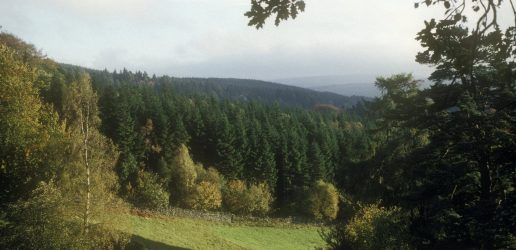Understanding and measuring the carbon and greenhouse gas balance of the UK’s woodlands and forests is an important aspect of Forest Research’s work. Carbon dioxide is an important greenhouse gas and as part of this research our scientists are monitoring the uptake and release of carbon dioxide from a local oak woodland.
During the growing season, the flows of carbon dioxide from woodland usually follow a 24-hour cycle, with a net uptake occurring during the day, whilst at night there is a net release. In other words, during the day the woodland is gaining carbon and during the night it is losing a small proportion of this.
There are many different things which affect the uptake and release of carbon dioxide from a woodland. One of them is temperature. We’ve been interested to see how the uptake and loss of carbon dioxide from the oak woodland we are monitoring, changed with the high temperatures experienced in the south of England from 16th – 22nd June.
The graph below shows the release and uptake of carbon dioxide from the oak woodland before, during and after the high temperatures. As we move from the bottom to the top of the left-hand axis of the graph we go from a situation where the trees are predominantly capturing carbon dioxide, to one where they are predominantly releasing it.

In the graph the average amount of carbon dioxide released and captured during the day and night is represented by the red lines. The dotted red lines show the averages before and after the high temperatures. The solid red line shows the averages during the high temperatures.
We can see that when temperatures were high the release and uptake of carbon dioxide seemed to be suppressed – in other words the woodland was capturing less during the day and releasing less carbon dioxide during the night.
Overall we think this would have had a negligible effect on the overall carbon balance of the woodland. Clearly it is difficult to say with any certainty what the effects of the high temperatures were over such a short period of time, but the data over those days seem to suggest that the temperatures were having an effect.
You might want to take a look at more information about our work monitoring and measuring the flows of carbon dioxide and other greenhouse gases from the woodland.
New research has been published which explores how to enable and encourage access to woodlands for diverse members of the public.
Forest Research has been involved in a project focusing on efforts to improve inclusivity in biosecurity practices by exploring how to integrate different knowledge systems into mainstream decision-making.

Forest Research has released the latest Accredited Official Statistics on woodland and forestry in the UK.
New research has been published which explores how to enable and encourage access to woodlands for diverse members of the public.
Forest Research has been involved in a project focusing on efforts to improve inclusivity in biosecurity practices by exploring how to integrate different knowledge systems into mainstream decision-making.

Forest Research has released the latest Accredited Official Statistics on woodland and forestry in the UK.